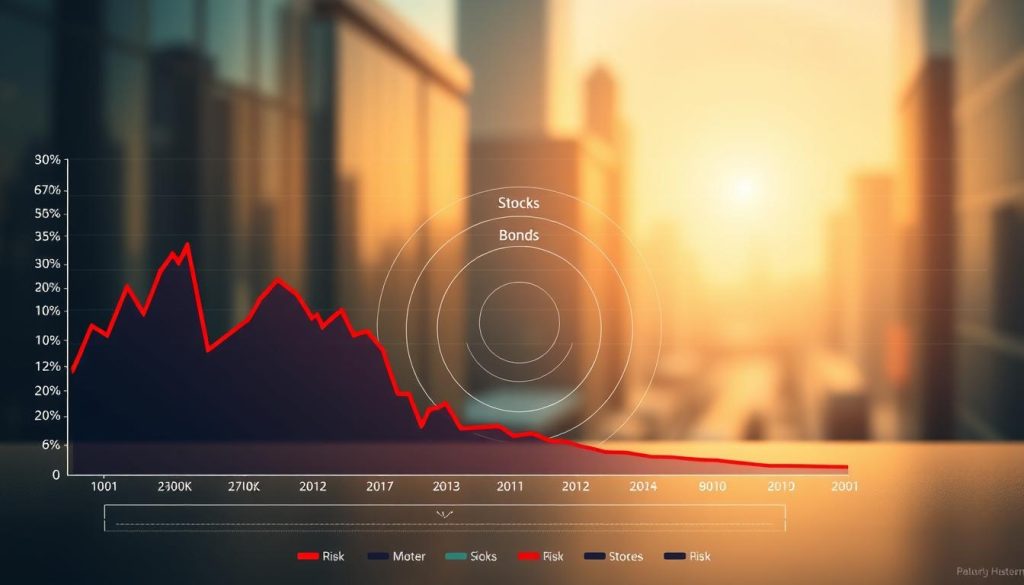Are you torn between investing in stocks or bonds? You’re not alone. Many investors struggle to decide which investment option is best for their financial goals.
Understanding the differences between these two investment types is crucial for making informed decisions. Investing in stocks can offer potentially high returns, but it comes with a level of risk. On the other hand, bonds are generally considered a safer investment, providing a fixed income stream.
So, how do you choose between the two? The answer lies in understanding your financial goals, risk tolerance, and investment horizon.
Key Takeaways
- Understand the differences between stocks and bonds to make informed investment decisions.
- Consider your financial goals, risk tolerance, and investment horizon when choosing between stocks and bonds.
- Stocks offer potentially high returns, but come with a level of risk.
- Bonds are generally considered a safer investment, providing a fixed income stream.
- Assess your investment options carefully to achieve your financial objectives.
Understanding the Basics of Stocks and Bonds
To make informed investment decisions, it’s crucial to understand the fundamentals of stocks and bonds. These two investment types are the cornerstone of many portfolios, offering different benefits and risks. Understanding their basics is key to navigating the financial markets effectively.
What Are Stocks?
Stocks represent ownership in a company, giving shareholders a claim on a portion of its assets and profits. When you buy stock, you’re essentially buying a small piece of that company. Stocks offer the potential for capital appreciation and dividend income, making them attractive to investors seeking growth.
What Are Bonds?
Bonds are debt securities issued by companies or governments to raise capital. When you buy a bond, you essentially lend money to the issuer, who promises to pay you back with interest. Bonds provide regular income through interest payments and tend to be less volatile than stocks, making them a more stable investment option.
Key Differences at a Glance
The primary differences between stocks and bonds lie in their risk profiles and return expectations. Stocks are generally riskier, with potential for higher returns, while bonds are typically more stable, with lower returns. Understanding these differences is crucial for making informed investment decisions that align with your financial goals and risk tolerance.
- Stocks offer potential for capital appreciation and dividend income.
- Bonds provide regular income through interest payments.
- Stocks are generally riskier than bonds.
Stocks vs Bonds Explained: Risk and Return Profiles
Understanding the risk and return profiles of stocks and bonds is crucial for making informed investment decisions. Investors need to weigh the potential benefits against the drawbacks of each investment type to construct a portfolio that aligns with their financial goals and risk tolerance.
Stock Market Risk vs Reward
Stocks are generally considered higher-risk investments due to their volatility and the potential for significant price fluctuations. However, this higher risk also comes with the potential for higher returns over the long term. As historical data has shown, stocks have outperformed bonds in terms of average annual returns over extended periods. For instance, a quote from a renowned investor, “The stock market is filled with individuals who know the price of everything, but the value of nothing,” highlights the complexity of stock investing.
“The stock market is filled with individuals who know the price of everything, but the value of nothing.”
Despite the risks, many investors are drawn to stocks because of their potential for long-term growth. It’s essential for investors to assess their risk tolerance and investment horizon before allocating a significant portion of their portfolio to stocks.
Bond Market Stability and Returns
Bonds, on the other hand, are typically viewed as more stable investments, offering regular income and relatively lower volatility. Government and high-quality corporate bonds are generally considered to be on the lower end of the risk spectrum. However, the trade-off for this stability is typically lower returns compared to stocks. Bonds provide a relatively stable source of returns, making them attractive to investors seeking predictable income.

Historical Performance Comparison
Historically, stocks have outperformed bonds over the long term, but with greater volatility. A comparison of the historical performance of stocks and bonds reveals that while stocks have offered higher average returns, they have also experienced more significant drawdowns during market downturns. Conversely, bonds have provided more stable returns, albeit at a lower level. Understanding these historical trends can help investors make more informed decisions about their investment allocations.
In conclusion, both stocks and bonds have their place in a well-diversified investment portfolio. By understanding their respective risk and return profiles, investors can make more informed decisions that align with their financial objectives and risk tolerance.
How to Evaluate Your Investment Goals
Understanding your investment goals is key to making informed decisions about your investments. Evaluating these goals involves several critical steps that help you determine the right investment strategy for your needs.
Determining Your Time Horizon
Your time horizon is the length of time you plan to hold your investments. It’s a crucial factor because it affects your ability to withstand market volatility. Generally, a longer time horizon allows for more aggressive investments, while a shorter horizon requires a more conservative approach.
Assessing Your Risk Tolerance
Risk tolerance is your ability to endure market fluctuations without selling your investments. Assessing your risk tolerance involves understanding your comfort level with potential losses and gains. This self-assessment will guide your allocation between stocks and bonds.
Defining Your Financial Objectives
Different financial objectives require different investment strategies. Whether you’re saving for retirement or short-term goals, your objectives will dictate your investment choices.
Retirement Planning
For long-term goals like retirement, a balanced portfolio that includes both stocks and bonds can be effective. Stocks offer growth potential, while bonds provide stability.
Short-Term Financial Goals
For short-term goals, prioritizing bonds or other low-risk investments may be more appropriate to avoid potential losses.
| Investment Goal | Recommended Investment | Risk Level |
|---|---|---|
| Retirement Planning | Balanced Portfolio (Stocks & Bonds) | Moderate |
| Short-Term Financial Goals | Bonds or Low-Risk Investments | Low |
By understanding your time horizon, risk tolerance, and financial objectives, you can make informed decisions about investing in stocks and bonds. This tailored approach helps in achieving your financial goals.
Steps to Choose Between Stocks and Bonds
Understanding when to prioritize stocks over bonds, or vice versa, is crucial for a successful investment strategy. The choice between these two investment options depends on several personal factors, including your financial goals, risk tolerance, and investment horizon.
When to Prioritize Stocks
Stocks are often considered a better option for certain investors due to their potential for high returns over the long term. Two scenarios where stocks might be prioritized are when you’re a young investor with a long time horizon or when you have a high risk tolerance.
Young Investors with Long Time Horizons
For young investors, the stock market can be an attractive place to grow your wealth over time. With a long investment horizon, you can ride out market fluctuations and potentially benefit from the compounding effect of your investments.
High Risk Tolerance Scenarios
If you have a high risk tolerance, you may be more inclined to invest in stocks, as you’re more comfortable with the possibility of significant price swings. Stocks offer the potential for higher returns, but it’s essential to be aware of the risks involved.

When to Prioritize Bonds
Bonds are generally considered a more conservative investment, providing regular income and relatively lower risk. Two scenarios where bonds might be the better choice are when you’re approaching retirement or when you’re focusing on income-generating strategies.
Approaching Retirement
As you near retirement, your investment priorities often shift from growth to income and capital preservation. Bonds can provide a stable source of income and help reduce the overall risk of your investment portfolio.
Income-Focused Strategies
If your primary goal is to generate regular income from your investments, bonds can be an attractive option. They typically offer regular interest payments, making them suitable for income-focused investment strategies.
Common Investment Mistakes to Avoid
When choosing between stocks and bonds, it’s essential to avoid common investment mistakes. These include failing to diversify your portfolio, not considering your risk tolerance, and making emotional decisions based on short-term market movements.
| Investment Type | Risk Level | Potential Return |
|---|---|---|
| Stocks | High | High |
| Bonds | Low to Medium | Medium |
By understanding your investment goals and risk tolerance, you can make an informed decision about whether stocks or bonds are better suited to your needs. A balanced approach that considers both investment options can help you achieve your financial objectives.
Building a Balanced Portfolio
The key to a successful investment strategy lies in building a balanced portfolio that aligns with your financial objectives. A balanced portfolio not only helps in managing risk but also in maximizing returns over the long term. It involves diversifying your investments across different asset classes, primarily stocks and bonds, to achieve a optimal mix.
Determining Your Ideal Stock-to-Bond Ratio
Determining the ideal stock-to-bond ratio is crucial for a balanced portfolio. This ratio should be based on your financial goals, risk tolerance, and investment horizon. A general rule of thumb is that the percentage of stocks in your portfolio should be 100 minus your age. For example, if you are 30 years old, you could have 70% of your portfolio in stocks and 30% in bonds.
Consider your risk tolerance: If you are risk-averse, you may want to allocate more to bonds. Conversely, if you can tolerate more risk, you might allocate more to stocks.
Diversification Strategies Within Asset Classes
Diversification within asset classes is essential to minimize risk. This involves spreading your investments across various types of stocks and bonds.
Types of Stocks to Consider
- Large-cap stocks: Stocks of large, established companies.
- Small-cap stocks: Stocks of smaller companies with growth potential.
- International stocks: Stocks from companies based outside your home country.
Types of Bonds to Consider
- Government bonds: Issued by governments, these are generally considered low-risk.
- Corporate bonds: Issued by companies, these offer higher yields but come with higher risk.
- Municipal bonds: Issued by local governments and municipalities, these offer tax advantages.
As the renowned investor, Warren Buffett, once said, “Diversification is protection against ignorance. It makes little sense if you know what you are doing.” This highlights the importance of understanding your investments.
“Price is what you pay. Value is what you get.” – Warren Buffett
How and When to Rebalance Your Portfolio
Rebalancing your portfolio is essential to maintain your ideal stock-to-bond ratio over time. As the value of your investments changes, your portfolio may become unbalanced. Regularly reviewing and rebalancing your portfolio ensures that it remains aligned with your investment goals.
It’s advisable to rebalance your portfolio periodically, such as every six months or when your investments deviate significantly from your target allocation.
Conclusion
Understanding the differences between stocks and bonds is crucial for making informed investment decisions. By grasping the concepts of stocks vs bonds explained, investors can better navigate the financial markets and create a portfolio that aligns with their financial goals.
Owning a mix of stocks and bonds can provide a balanced approach to investing, allowing individuals to manage risk while potentially earning returns. The benefits of owning stocks and bonds include diversification, income generation, and capital appreciation.
By evaluating your investment goals, risk tolerance, and time horizon, you can make informed decisions about your investment portfolio. Understanding investment options is key to achieving financial success, and with the right knowledge, you can take control of your financial future.

Leave a Reply